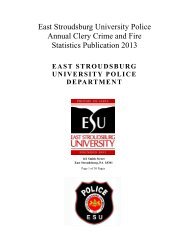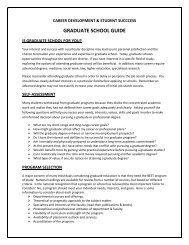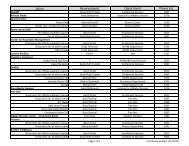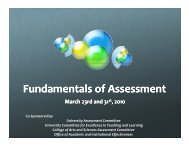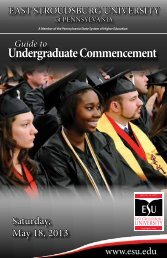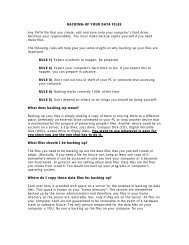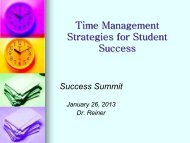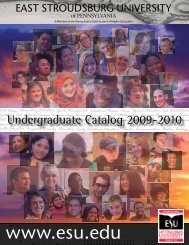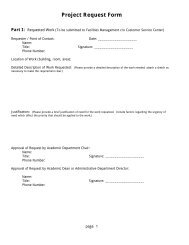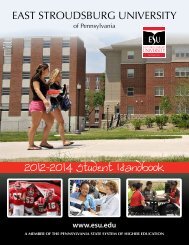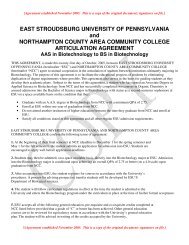2011-2012 report - East Stroudsburg University
2011-2012 report - East Stroudsburg University
2011-2012 report - East Stroudsburg University
You also want an ePaper? Increase the reach of your titles
YUMPU automatically turns print PDFs into web optimized ePapers that Google loves.
ESU students walk through the community in St. Croix with Ginger Thomas residents.<br />
A Tropical Journey of Learning and Compassion<br />
St. Croix, U.S. Virgin Islands by Crystal Swartz<br />
Picture tropical paradise. Caribbean blue<br />
waters ripple onto sandy shorelines as nearby<br />
palm trees gently fan the massive sky. The<br />
St. Croix setting prompted <strong>East</strong> <strong>Stroudsburg</strong><br />
<strong>University</strong> psychology professor Dr. Richard<br />
Wesp to remind parents and students, when<br />
writing the course description for his “Cross<br />
Cultural Comparison of Behavior Therapy”<br />
class, that the two-week stay on the island was<br />
not going to be spring break. With a calm voice<br />
and patient demeanor, Dr. Wesp discusses the<br />
unique service-learning course he developed a<br />
decade ago.<br />
The two-week psychology course begins inside<br />
an ESU classroom in May. Dr. Wesp teaches a<br />
small number of students (between 8 and 13) a<br />
week’s worth of behavioral-therapy approaches<br />
and cultural competency. Then Dr. Wesp and<br />
his class hop on a plane to St. Croix in the U.S.<br />
Virgin Islands. But the Caribbean island houses<br />
more than powder beaches<br />
and turquoise<br />
waters.<br />
Here, at the Ginger Thomas Residence for<br />
Disabled Adults, ESU students unpack their<br />
classroom knowledge and get to work. While<br />
the Ginger Thomas residents vary in age,<br />
gender, and disorders, they share an acute<br />
need for behavioral therapy. Miles away from<br />
PowerPoint presentations, the students apply<br />
the treatment approaches in a practical setting.<br />
In addition to psychological concepts, cultural<br />
competency is also important to assess<br />
the residents’ needs. Because the residents<br />
live with limited communication skills and<br />
physical disabilities, student volunteers<br />
provide a comfortable, yet engaging, balance of<br />
individualized therapy. Each day challenges and<br />
enriches the residents, students, and Dr. Wesp.<br />
In the morning, Dr. Wesp and the class<br />
arrive at the Ginger Thomas Residence. After<br />
assessing specific needs, the students plan<br />
daily agendas. Students decide what to teach<br />
and break down the process into steps. “I<br />
want the students to look at the individual’s<br />
strengths and weaknesses and plan<br />
from there,” said Dr. Wesp.<br />
A simple activity like working<br />
with building blocks to teach the<br />
residents eye-hand coordination<br />
involves<br />
numerous<br />
steps. At times,<br />
a resident’s<br />
fluctuating<br />
behavior has the tendency to<br />
The <strong>2012</strong> class signed a conch shell<br />
given by the residents to ESU.<br />
alter planned agendas. “Our work depends on<br />
their temperament. If they didn’t sleep well,<br />
we’ll go out on the porch and bang on some<br />
instruments. Or we’ll walk along the water<br />
down to the port,” Dr. Wesp said. He feels the<br />
exposure within the community has reciprocal<br />
benefits. He continued, “It’s important for the<br />
community to know who their neighbors are.<br />
They are very supportive, many people wave<br />
and say hello as we take our group walks.”<br />
In their free time, Dr. Wesp and the students<br />
take in the cultural fare and historic sights<br />
of St. Croix. These explorations include the<br />
Columbus Landing Site, Fort Christiansted and<br />
Bucks Island, an underwater U.S. National Park.<br />
Dr. Wesp describes their accommodations<br />
as small white cottages with bunk beds and<br />
kitchens. The natural beauty of the simple white<br />
cottages arises from their secluded location.<br />
They’re scattered right along the beach,<br />
footsteps from the ocean, so it’s no wonder the<br />
insides of the cottages receive little attention.<br />
Toward the end of the<br />
stay, ESU students join<br />
the <strong>University</strong> of Virgin<br />
Islands’ (UVI) psychology<br />
club students for a dinner.<br />
Dr. Wesp chuckles and<br />
compares the dinner to a<br />
junior high school dance<br />
as he recalls the first year.<br />
“ESU students were on<br />
one side of the room, UVI<br />
students on the other;<br />
they didn’t mingle,” he said. UVI psychology<br />
professor Dr. Aletha Baumann and Dr. Wesp<br />
collaborated and figured out a way to initiate<br />
engagement. A cultural scavenger hunt did<br />
the trick. Every year, UVI students create a<br />
list of cultural items for ESU students to find.<br />
Previous lists included a recipe for the popular<br />
St. Croix<br />
callaloo stew<br />
and photos of<br />
island senators.<br />
In addition to<br />
improving peer<br />
relations, the<br />
scavenger hunt<br />
encourages<br />
ESU<br />
ESU students and faculty in St. Croix students to<br />
communicate with Caribbean natives. UVI<br />
students end the evening by awarding ESU<br />
students with native products, like CDs of<br />
island music, at the festive, interactive dinners.<br />
Students from the <strong>2012</strong> class watch the sunset and reflect.<br />
The “Cross Cultural<br />
Comparison of Behavior<br />
Therapy” course was<br />
originally designed<br />
for psychology majors<br />
and was offered in the<br />
winter session. “It has<br />
changed here and there<br />
along the way,” said<br />
Dr. Wesp. Eventually<br />
the course opened to<br />
include students who<br />
were not psychology majors, and it moved<br />
from the winter term to the summer term.<br />
In his eleventh year of course instruction, Dr.<br />
Wesp continues to receive positive feedback<br />
from previous students about their St. Croix<br />
experience. They credit the social-services<br />
program for success in their current careers.<br />
He added, “In interviews, potential employers<br />
seem to be quite interested with their hands-on<br />
experience. The students learn the theories and<br />
work directly to gain concrete perspectives.”<br />
Past participant and current psychology major<br />
Mary-Kate Carolan said: “The experience was<br />
both challenging and rewarding.” Initially, she<br />
added, it was challenging to see a portion of<br />
Ginger Thomas residents unable to recognize<br />
the students’ presence. However, working<br />
through obstacles helped Carolan gain<br />
significant insight. “It is so important to<br />
continue education about mental awareness,<br />
not just in school, but at home as well.<br />
Children need to learn that when a person<br />
has a mental and/or physical disability, there<br />
isn’t anything wrong with them,” she said.<br />
“Cross Cultural Comparison of Behavior<br />
Therapy” begins inside Stroud Hall each<br />
May. The theories are carried to St. Croix<br />
and practiced within the Ginger Thomas<br />
Residence. Immersed in a diverse environment,<br />
students further acquire cultural awareness.<br />
However, the course does not end in the<br />
U.S. Virgin Islands. Dr. Wesp’s instruction<br />
and guidance in this social service program<br />
provide ESU students a growing step<br />
to continue onward.<br />
The <strong>2012</strong> class examines a restored sugar mill while touring.<br />
06 Arts & Sciences College Annual Report <strong>2011</strong>–12 07



